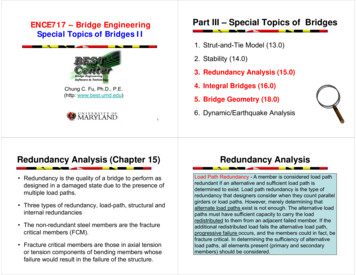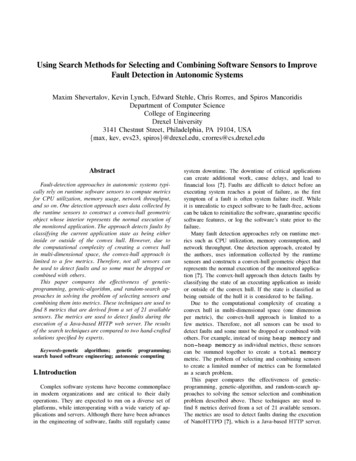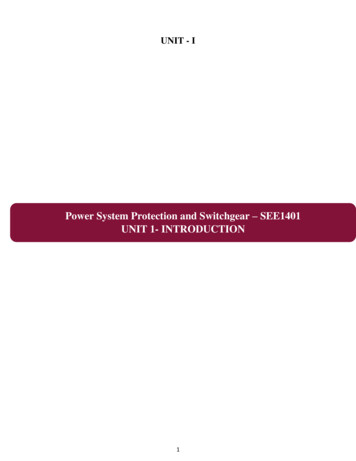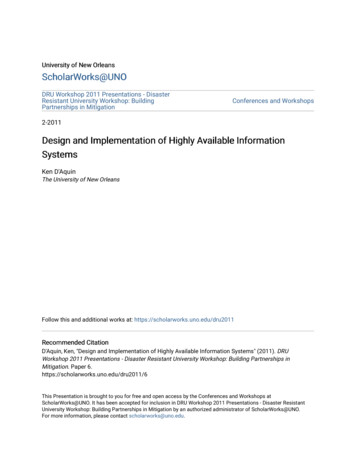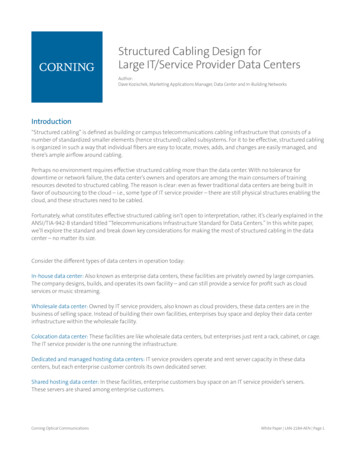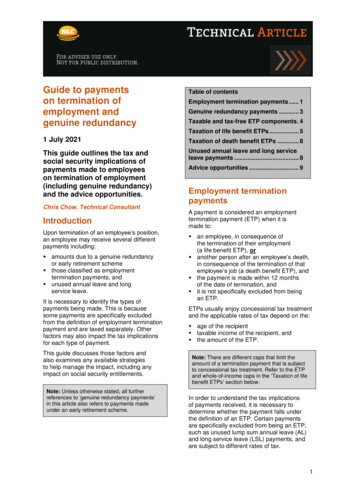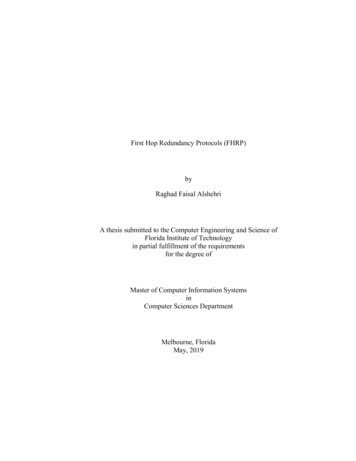
Transcription
Handling Software Faults with Redundancy?Antonio Carzaniga1 , Alessandra Gorla1 , and Mauro Pezzè1,21University of Lugano, Faculty of Informatics,via Buffi 13, 6900, Lugano, Switzerlandantonio.carzaniga@usi.ch, alessandra.gorla@usi.ch, mauro.pezze@usi.ch2University of Milano-Bicocca, Dipartimento di Informatica, Sistemistica eComunicazione, Via Bicocca degli Arcimboldi 8, 20126, Milano, ItalyAbstract. Software engineering methods can increase the dependabilityof software systems, and yet some faults escape even the most rigorousand methodical development process. Therefore, to guarantee high levelsof reliability in the presence of faults, software systems must be designedto reduce the impact of the failures caused by such faults, for exampleby deploying techniques to detect and compensate for erroneous runtimeconditions. In this chapter, we focus on software techniques to handlesoftware faults, and we survey several such techniques developed in thearea of fault tolerance and more recently in the area of autonomic computing. Since practically all techniques exploit some form of redundancy,we consider the impact of redundancy on the software architecture, andwe propose a taxonomy centered on the nature and use of redundancyin software systems. The primary utility of this taxonomy is to classifyand compare techniques to handle software faults.1IntroductionThis work addresses the engineering of software systems that are used in thepresence of faults. Arguably, despite mature design and development methods,despite rigorous testing procedures, efficient verification algorithms, and manyother software engineering techniques, the majority of non-trivial software systems are deployed with faults. Also, in practice, computing systems cannot existin isolation as purely mathematical objects, and therefore are inevitably affectedby faults. For these reasons, we accept the assumption that many systems cannot be completely rid of faults, and that the reliability of such systems canbe improved by allowing them to prevent or alleviate the effects of faults, andperhaps even to correct the faults at runtime. These are essentially the goals ofmuch research in the area of fault tolerance [1, 2] and more recently in autonomiccomputing [3, 4].There are important differences between the approaches to reliability foundin the fault tolerance and autonomic computing literature, respectively. First, ata high level, fault tolerance is a more focused area, while autonomic computing?This work was supported by the Swiss National Science Foundation under thePerSeoS and WASH projects.
covers a larger set of objectives. In fact, the term autonomic computing refersto the general ability of a system to respond to various conditions such as performance degradation or changes in the configuration of the environment, manyof which may not be caused nor affected by faults. In this chapter we will limitourselves to a sub-area of autonomic computing, typically called self-healing,whose specific objective is to achieve an automatic reaction to, or prevention offunctional faults and failures.Another difference is in the nature of the intended application domain. faulttolerance research has been driven primarily by highly specialized and safetycritical systems, whereas autonomic computing—specifically, self-healing—is targeted towards general purpose components or loosely coupled systems where theeffects of failures are less destructive. These two application domains also havesignificant differences in the levels of costs and ultimately in the type of designsthat are considered acceptable.Yet another difference is that fault tolerance research explicitly addressesboth hardware and software faults with different techniques that may be hardware or software, while self-healing research does not distinguish different classesof faults and has so far studied mostly software techniques. Finally, classic faulttolerance approaches have a stronger architectural implications than many recent self-healing approaches.Their differences not withstanding, fault tolerance and self-healing in autonomic computing share the same goal of rendering software systems immuneor at least partially resilient to faults. Therefore, in this chapter we propose tounify the contributions of these two somewhat separate research areas in a coherent classification. In particular, we propose to focus on what we see as thecentral, common element of most of the techniques developed in both communities, namely redundancy. We will pay particular attention to techniques thathandle software faults, and to their architectural implications.A system is redundant when it is capable of executing the same, logicallyunique functionality in multiple ways or in multiple instances. The availability ofalternative execution paths or alternative execution environments is the primaryingredient of practically all systems capable of avoiding or tolerating failures. Forexample, a fairly obvious approach to overcome non-deterministic faults, such ashardware faults, is to run multiple replicas of the system, and then simply switchto a functioning replica when a catastrophic failure compromises one of thereplicas. In fact, redundant hardware has been developed since the early sixtiesto tolerate development faults as well as manufacturing faults in circuits [5–7]. Ananalogous form of redundancy is at the core of many widely studied replicationtechniques used to increase the availability of data management systems [8].Similarly, redundancy has been used extensively to tolerate software faults [1].This paper focuses primarily on techniques that exploit software redundancy fortolerating such faults.Software poses some special challenges and also provides new opportunitiesto exploit redundancy. For example, while simple replication of components canhandle some classes of production faults typical of hardware design, it cannot
deal with many failures that derive from development and integration problemsthat occur often in software systems. On the other hand, software systems areamenable to various forms of redundancy generally not found in hardware systems. A form of redundancy for software systems that is analogous to basicreplication techniques used for non-deterministic hardware faults is N-versionprogramming. In this case, replicas run independently-developed versions of thesame system, and therefore may also be able to tolerate deterministic faults [9].As another example, consider a self-healing system that, in order to overcomedeterministic faults, detects the faulty component and redirects every requestfor that faulty component to another, more or less equivalent component [10,11].The availability of such a replacement component is a form of redundancy,and is also generally applicable to hardware systems. However, the nature ofsoftware components and their interactions may make this technique much moreeffective, in terms of time and costs, for software rather than hardware components. Yet another example is that of micro-reboots, which exploit another formof redundancy rooted in the execution environment rather than in the code. Inthis case, the system re-executes some of its initialization procedures to obtaina fresh execution environment that might in turn make the system less prone tofailures [12, 13].Having centered our taxonomy on redundancy, we proceed with a high-levelclassification by examining the following four questions. We first ask what isthe intent of redundancy. We ask whether a fault tolerance mechanism relies onredundancy that is deliberately added to the system, or whether the mechanismopportunistically exploits redundancy that occurs naturally in the system. Forexample, N-version programming is clearly a deliberate form of redundancy,while micro-reboots are opportunistic in nature, since they do not require thedesign of redundant code. This question of intent is correlated with the costsand effectiveness of a technique: Generally speaking, redundancy established bydesign is more effective but also more costly. This question is also importantbecause it may highlight useful forms of latent redundancy, that is, forms ofredundancy that, even though not intentionally designed within a system, maybe exploited to increase reliability.Then, we ask what type of redundancy is employed in a particular system.This question in effect identifies the elements of the execution of the system thatare made redundant. The three high-level categories we distinguish are code,data, and environment, which follow quite closely the taxonomy proposed byAmmar et al., who introduce the concepts of spatial, information and temporalredundancy [14]. For example, micro-reboot employs redundancy in the execution environment, whereas N-version programming amounts to code redundancy.Third, we look at how redundancy is used. Specifically, we ask whether itis used preventively, to avoid failures, or reactively to mask or otherwise compensate for the effects of faults. For example, the recovery blocks mechanism isreactive, while software rejuvenation is preventive [15]. In the case of methodsthat use redundancy reactively, we also explore the nature of the failure detectors
needed to trigger the reaction, and the corrective measures used in the reaction.We examine these two aspects especially in relation to redundancy.The fourth question differentiates mechanisms according to the nature of thefaults they are most effective with. We distinguish two large classes of faults:those that affect a system deterministically when given the same input vector,and those that are non-deterministic in nature, for instance because of someinherent non-determinism of the system or most likely its environment. Faultsof these two classes are often referred to as Bohrbugs and Heisenbugs, respectively [16, 17].Fault tolerance and autonomic computing are well-established research areas.The former is arguably more mature, but the latter has received more attentionin recent years, and both have been surveyed extensively. Most surveys of thesetwo areas either focus on specific techniques and applications, or adopt generalconceptual models and a historical perspective. In any case, existing surveysconsider only one of these two areas. For example, Huebscher and McCanne review many techniques developed in the context of of self-managed systems [18]but do not relate them to fault tolerance. Specifically, they organize their survey around a foundational but rather high-level model of autonomic computing.At the other end of the spectrum, De Florio and Blondia compile an extensivesurvey of software fault tolerance techniques [19]. In particular, they discusssome techniques related to redundancy (for instance, N-version programming)but primarily they review domain-specific languages and other linguistic techniques to enhance the reliability of software systems at the application level.Another related survey is one by Littlewood and Strigini [20], who examine thebenefits of redundancy—specifically diversity—to increase system reliability inthe presence of faults that pose security vulnerabilities. Yet another example ofa focused survey is the widely cited work by Elnozahy et al. on rollback-recoveryprotocols [21].Particularly interesting in the scope of this paper are the taxonomies by Ammar et al. [14] and Avizienis et al [2]. Ammar et al. propose an extensive surveyof the different aspects of fault tolerance techniques, and, in this context, distinguish spatial, information and temporal redundancy. This taxonomy focuseson the dimensions of redundancy, and matches well the differences of redundanttechniques for handling hardware as well as software faults. The classification interms of code, data and environment redundancy adapts better to different typesof redundancy introduced in the context of fault tolerance as well as self-healingresearch to handle software faults. Avizienis et al. propose a fault taxonomy thathas become a de-facto standard. In this chapter, we refer to Avizienis’ terminology and taxonomy limited to the aspects relevant to software faults.Our goal with this survey is rather different. First, at a high level, we take abroad perspective on this field and consider a wide range of techniques. Thereforewe do not attempt to examine every technical aspect of each technique in greatdetail. Nevertheless, we make an effort to maintain a strictly technical approachin our classification, distinguishing methods and systems on the basis of theirtechnical features and merits, and regardless of the conceptual model used to
describe them or the application domain for which they were developed. Second,we intend to unify the two areas of fault tolerance and self-healing under a singletaxonomy, ignoring the historical path that lead to one technique or another,and instead basing our taxonomy on what we see as the essential, common ideasbehind both fault tolerance and self-healing. Finally, we focus on techniquesfor handling software faults, and we discuss the different aspects as well as theoverall architectural implications.In Section 2 we discuss the main architectural implications of redundancy,and we identify few simple design patterns. In Section 3 we detail the classification method we used in our survey. We then proceed with the analysis of severalsystems, first in Section 4 where we discuss systems based on the deliberate useredundancy, and then in Section 5 where we discuss opportunistic redundancy.2Architectural ImplicationsAlthough implicitly discussed in different papers, the architectural implicationsof fault tolerance mechanisms have been explicitly addressed only recently. Gacekand de Lemos suggest that dependability should be designed at the architecturelevel, and define the requirements for embedding fault tolerant approaches intoarchitectural description languages [22]. Feiler and Rugina enrich the architectural description language AADL with error annexes to model dependabilityat the architectural level. Harrison and Avgeriou discuss the implementabilityof fault tolerance tactics within different architectural patterns [23]. Hanmerpresents an extensive set of patterns for error and fault handling [24]. In thissection, we shortly illustrate the conceptual impacts of redundancy on softwarearchitectures.From the software architecture viewpoint, redundancy can be introduced either at intra- or at inter-component level. When introduced at intra-componentlevel, redundancy does not alter the structure of the connections between components, but only the single components. This is the case for example of wrappersthat filter component interactions, robust data structures that introduce redundancy at the level of data structure to handle data related faults, and automaticworkarounds that exploit redundancy that is implicitly present in the program.When introduced at inter-component level, we can recognize few recurrentpatterns that are shown in Figure 1. In the parallel evaluation pattern, an adjudicator evaluates the results of several alternative implementations that areexecuted in parallel. The adjudicator is often a simple voting mechanism thatidentifies failures. This is the case for example of N-version programming thatexecutes N different versions with the same input configuration, and of datadiversity and process replicas that execute identical copies with different input configurations. In the parallel selection pattern, the adjudicator is active atthe end of each program executed in parallel to validate the result and disablefailing components. The pattern is implemented in self-checking programming.In the sequential alternative pattern, alternative programs are activated whenadjudicators detect failures. This pattern is implemented by recovery blocks,
self-optimizing applications, registry-based recovery, data diversity and servicesubstitution approaches. We will discuss the different approaches in more detailsin the next sections when introducing a taxonomy for redundancy.3A Taxonomy for RedundancyAs discussed in the introduction, both fault tolerance and autonomic computingare well established research areas, and both have been surveyed extensively.Particularly interesting for this paper are the surveys by Ammar et al. [14],Elnozahy et al. [21], Littlewood and Strigini [20], and De Florio and Blondia [19],who survey approaches to fault tolerance and the use of redundancy in faulttolerance from different perspectives, and the work by Huebscher and McCannewho survey approaches to self-managed systems [18]. All these surveys focus oneither fault tolerance or self-healing systems, and none of them suites well bothresearch areas. The taxonomy proposed in this paper aims to provide a unifyingframework for the use of redundancy for handling software faults both in faulttolerant and self-healing systems.To survey and compare the different ways redundancy has been exploited inthe software domain, we identify some key dimensions upon which we define ataxonomy of fault tolerance and self-healing techniques. These are the intentionof redundancy, the type of redundancy, the nature of triggers and adjudicatorsthat can activate redundant mechanisms and use their results, and lastly theclass of faults addressed by the redundancy mechanisms. Table 1 summarizesthis high-level classification scheme.Table 1. Taxonomy for redundancy based dedataenvironmentTriggers and adjudicators:preventive (implicit adjudicator)reactive: implicit adjudicatorexplicit adjudicatorFaults addressed by redundancy: interaction - maliciousdevelopment: BohrbugsHeisenbugsIntention Redundancy can be either deliberately introduced in the design orimplicitly present in the system and opportunistically exploited for fault handling. Some approaches deliberately add redundancy to the system to handlefaults. This is the case, for example, of N-version programming that replicatesthe design process to produce redundant functionality to mask failures in single
configurationC1C2Cn.adjudicator(a) Parallel orNOOKFAILOKOK(b) Parallel catorOKFAILOK(c) Sequential alternativesFig. 1. Main architectural patterns for inter-component redundancy.
modules [9]. Other approaches opportunistically exploit redundancy latent in thesystem. This is the case, for example, of automatic workarounds that rely on theequivalence of different compositions of the internal functionality [25]. Althoughapproaches from both categories can be applied to different classes of systems,deliberately adding redundancy impacts on development costs, and is thus exploited more often in safety critical applications, while opportunistic redundancyhas been explored more often in research on autonomic and self-healing systems.Type A system is redundant when some elements of its code, its input data, or itsexecution environment (including the execution processes themselves) are partially or completely replicated. Some approaches rely on redundant computationthat replicates the functionality of the system to detect and heal a faulty computation. For example, N-version programming compares the results of equivalentcomputations to produce a correct result. This is a case of code redundancy.Other approaches rely on redundancy in the data handled during the computation. For example, so-called data diversity relies on redundancy in the dataused for the computation, and not on the computation itself, which is based onthe same code [26]. Yet other approaches exploit environmental conditions thatinfluence the computation. For example environment perturbation techniquesrely on redundancy that derive from different reactions of the environment [27].Different types of redundancy apply to different types of systems and differentclasses of faults. As indicated in the introduction, the classification based on thetype of replicated elements is similar to Ammar’s classification in spatial, information and temporal redundancy [14] that applies better to the more generalkind of redundancy that can be found when considering techniques to handleboth hardware and software faults.Triggers and adjudicators Redundant components can be either triggered preventively to avoid failures, or exploited reactively in response to failures. In thefirst case, the system must decide when and where act to maximize the chance ofavoiding failures. Examples of the preventive use of redundancy are rejuvenationtechniques that reboot the system before failures occur [15]. In the second case,the system must at a minimum detect a failure, and therefore decide how to exploit the redundancy of the system in order to cope with the failure. We refer tothe component of the system that makes these decisions as the adjudicator. Wefurther classify a system by distinguishing adjudicators that are either implicitly built into the redundant mechanisms, or explicitly designed by the softwareengineers for a specific application. For example, N-version programming revealerrors automatically by comparing the results of executing redundant equivalentcode fragments; the result is chosen with a majority vote between the differentexecutions, and therefore amounts to an implicit adjudicator. On the other hand,recovery-blocks require explicit adjudicators that check for the correctness of theresults to trigger alternative computations [28].Faults Redundancy may be more or less effective depending on the types offaults present in the system. In our taxonomy, we indicate the primary class of
faults addressed by each mechanism. In particular, we refer to the fault taxonomy proposed by Avizienis et al. and revised by Florio et al. [2, 19]. Avizienis etal. distinguish three main classes of faults: physical, development, and interactionfaults. Physical faults are hardware faults caused either by natural phenomenaor human actions. Examples of physical faults are unexpected lacks of power,or physical hardware damages. Development faults are faults introduced duringthe design of the system, for example incorrect algorithms or design bottlenecks.Interaction faults are faults that derive from the incorrect interaction betweenthe system and the environment, for example, incorrect settings that cause badinteractions with the system or malicious actions that aim to violate the system security. In this chapter, we focus on software faults, and thus we considerdevelopment and interaction faults, and not physical faults that are related tohardware problems. We further distinguish development faults that consistentlymanifest under well defined conditions (Bohrbugs) form development faults thatcause software to exhibit non-deterministic behavior (Heisenbugs) [17, 16], andwe refer to interaction faults introduced with malicious objectives [2].Table 2 summarizes the main exploitations of redundancy in fault toleranceand self-healing systems, characterized according to the categories introducedin this section. In the following sections, we discuss the taxonomy illustratedin Table 2. Here we identify the techniques listed in the table with a quickdescription and a reference to the main architectural implications. N-versionprogramming compares the results of executing different versions of the program to identify errors (parallel evaluation pattern). Recovery blocks check theresults of executing a program version and switch to a different version if thecurrent execution fails (sequential alternatives pattern). Self-checking programming parallelizes the execution of recovery blocks (parallel selection pattern).Self-optimizing code changes the executing components to recovery from performance degradation (sequential alternatives pattern). Exception handling activates handlers to manage unplanned behaviors (sequential alternatives pattern).Rule engines code failure handlers that are activated through registries (sequential alternatives pattern). Wrappers intercept interactions and fix them whenpossible (intra-component). Robust data structures and software audits augmentdata structures with integrity checks (intra-component). Data diversity executesthe same code with perturbed input data (either parallel selection or sequentialalternatives pattern). Environment perturbation changes the execution environment and re-executes the failing code. Rejuvenation preventively reboots thesystem to avoid software aging problems. Process replicas execute the same process in different memory spaces to detect malicious attacks. Dynamic servicesubstitution links to alternative services to overcome failures (sequential alternatives pattern). Genetic programming for fault fixing applies genetic algorithmsto fix faults (intra-component). Automatic workarounds exploit the intrinsic redundancy of software systems to find alternative executions (intra-component).Checkpoint-recovery rebuilds a consistent state and re-executes the program.Reboot and micro-reboot restart the system to recovery from Heisenbugs.
Table 2. A taxonomy of redundancy for fault tolerance and self-managed systemsN-version programming[9, 29–31]Recovery blocks[28, 29]Self-checking programming[32, 29, 33]Self-optimizing code[34, 35]Exception handling, rule engines[36–38]Wrappers[39–42]Robust data structures, audits[43, 44]Data diversity[26]Data diversity for security[45]Rejuvenation[46, 15, 17]Environment perturbation[27]Process replicas[47, 48]Dynamic service substitution[10, 49, 11, 50]Fault fixing, genetic programming[51, 52]Automatic workarounds[53, 25]Checkpoint-recovery[21]Reboot and micro-reboot[12, iccodeopportunistic environmentopportunistic lopmentHeisenbugsHeisenbugs
4Deliberate RedundancyDeliberately adding redundancy is common practice in the design of computersystems at every level, from single registers in a processor to entire componentsin a computer, to entire computers in a data center. In this section, we surveysoftware fault tolerance and self-healing techniques that deliberately introduceredundancy into software systems at the code, data and environment levels.4.1Deliberate Code RedundancyDeliberate software redundancy has been widely exploited at the code level.Classic approaches explored the use of N-version programming and recoveryblocks to tolerate software faults. Later approaches introduced the concepts ofself-checking and self-optimizing programming to overcome a wider variety offaults as well as performance issues. Recently some approaches proposed variousforms of registries to identify healing procedures, mostly in the context of BPELprocesses. A different form of deliberate code redundancy, defined in variouscontexts, is represented by wrappers. Wrappers add redundant code to detectand correct interaction problems such as incompatibilities of formats or protocolsbetween software components.N-version programming The approach was originally proposed by Avizienis etal., and is one of the classic approaches to the design of fault tolerant softwaresystems [9]. N-version programming relies on several programs that are designedindependently and executed in parallel. The results are compared to identify andcorrect wrong outputs. The multiple versions must differ as much as possiblein the use of design and implementation techniques, approaches, and tools. Ageneral voting algorithm compares the results, and selects the final one basedon the output of the majority of the programs. Since the final output needs amajority quorum, the number of programs determines the number of tolerablefailures: a three-versions system can tolerate at most one faulty result, a fiveversions system can tolerate up to two faulty results, and so on. In general, inorder to tolerate k failures, a system must consists of 2k 1 versions.The original N-version mechanism has been extended to different domains, inparticular recently to the design of web- and service-based applications. Lookeret al. define WS-FTM, a mechanism that supports the parallel execution ofseveral independently-designed services. The different services implement thesame functionality, and their results are validated on the basis of a quorumagreement [30]. Dobson implements N-version programming in WS-BPEL, byimplementing the parallel execution of services with a voting algorithms onthe obtained responses [29]. Gashi et al. describe and evaluate another typical application of N-version programming to SQL servers [31]. In this case, Nversion programming is particularly advantageous since the interface of an SQLdatabase is well defined, and several independent implementations are alreadyavailable. However, reconciling the output and the state of multiple, heterogeneous servers may not be trivial, due to concurrent scheduling and other sourcesof non-determinism.
N-version programming is a relevant instance of deliberate code-level redundancy, since it requires the design of different versions of the same program.The approach relies on an general built-in consensus mechanism, and does notrequire explicit adjudicators: The voting mechanism detects the effects of faultsby comparing the results of the program variants, and thus acts as a reactive,im
data, and environment, which follow quite closely the taxonomy proposed by Ammar et al., who introduce the concepts of spatial, information and temporal redundancy [14]. For example, micro-reboot employs redundancy in the execu-tion environment, whereas N-version programming amounts to code redundancy. Third, we look at how redundancy is used.
